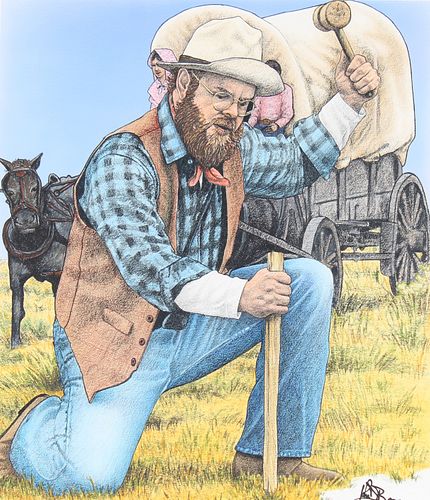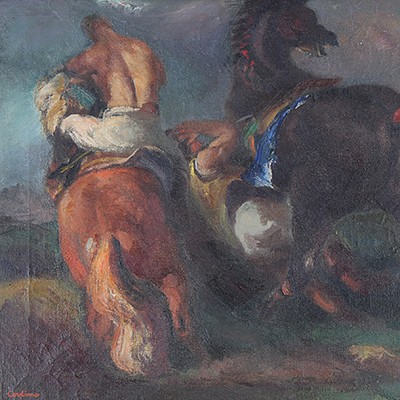John Benson (B. 1949) "Homesteader"
Lot 228
Estimate:
$250 - $450
Absentee vs Live bid
Two ways to bid:
- Leave a max absentee bid and the platform will bid on your behalf up to your maximum bid during the live auction.
- Bid live during the auction and your bids will be submitted real-time to the auctioneer.
Bid Increments
| Price | Bid Increment |
|---|---|
| $0 | $10 |
| $100 | $25 |
| $250 | $50 |
| $1,000 | $100 |
| $2,500 | $250 |
| $7,500 | $500 |
| $20,000 | $1,000 |
| $50,000 | $2,500 |
| $100,000 | $5,000 |
| $250,000 | $10,000 |
About Auction
By Helmuth Stone Gallery
Apr 18, 2021
Set Reminder
2021-04-18 13:00:00
2021-04-18 13:00:00
America/New_York
Bidsquare
Bidsquare : Important Fine Art, Chinese Antiques & Jewelry
https://www.bidsquare.com/auctions/helmuth-stone-gallery/important-fine-art-chinese-antiques-jewelry-6771
Over 400 lots of fine art, Asian antiques, and jewelry from an important California private collection. Visit HelmuthStone.com for more information. Helmuth Stone Gallery helmuthstone@gmail.com
Over 400 lots of fine art, Asian antiques, and jewelry from an important California private collection. Visit HelmuthStone.com for more information. Helmuth Stone Gallery helmuthstone@gmail.com
- Lot Description
John Benson (American, B. 1949) "Oklahoma Territory Land Rush/Homesteader" Signed lower right. Original Mixed Media painting on Paper.
Provenance: Collection of James A. Helzer (1946-2008), Founder of Unicover Corporation.
This painting was originally published on the Fleetwood First Day of issue U.S. Postal Card for Settling of Oklahoma issued April 22, 1989.
The state of Oklahoma was settled quite late compared to the states around it. Once settlement began, however, it happened practically overnight. In the beginning, the area was inhabited only by Native Americans who followed huge herds of buffalo across the grasslands. These nomads were joined later by eastern tribes forced to move west and out of the way of white settlement. Treaties promised the lands of Oklahoma to the Indians "as long as grass shall grow and rivers run." After the Civil War, however, the treaties were broken. First, land was taken from tribes who had "supported the South." This land was to be distributed among other, loyal tribes, but when there was no more free or cheap land available elsewhere to white settlers, it was quickly opened to land-starved pioneers. Almost 1.9 million acres in central Oklahoma became available for settlement at noon, April 22, 1889. About 50,000 people moved into Oklahoma by that evening. In a single day, Guthrie and Oklahoma City acquired over 10,000 inhabitants. In 1893, another part of Oklahoma was opened in the same manner; other lands were distributed by lottery. The area became known as the Twin Territories -- what remained of the Indian Territory, where Native Americans still held land, and Oklahoma Territory, settled by whites. Delegates from these territories drew up a constitution as one entity, and on November 16, 1907, Oklahoma was admitted to the Union as the 46th of the United States.
Image Size: 14 x 12 in.
Overall Size: 23 x 20 in.
Unframed.
(B12002)Condition
- By registering to bid for this auction either in-house or online and/or placing a bid in this auction the BIDDER/BUYER agrees to all the terms and conditions of Helmuth Stone Gallery Auctions.
- All silver, gold and/or jewelry lots or invoices containing said lots MUST be paid for via WIRE TRANSFER, no other forms of payment will be accepted.
- All items are sold as-is where-is and no guarantees are made of any kind. All sales are final; no refunds will be given under any circumstances.
- Helmuth Stone Gallery provides condition reports as a courtesy to our clients and assumes no liability for any error or omission. Any condition statement is given as a courtesy to a client and is only an opinion and should not be treated as a statement of fact. Descriptions are our opinions and should in no way be construed as a guarantee of any kind as to age, condition, mater. The bidder assumes responsibility for ensuring that the condition of the item(s) meets with their satisfaction prior to bidding. The absence of a condition statement does not imply that the lot is in perfect condition or completely free from wear and tear, imperfections or the effects of aging.
- Online images can sometimes be low quality due to the uploading process, original high-resolution images can be requested via email at HelmuthStone@gmail.com
- We recommend looking into shipping quotes prior to bidding, shipping quotes can take up to a week or more post-sale as we host our auctions through multiple online platforms and shipping can become backlogged, if you would like a list of local shippers please email us directly.
- Our auction catalogs are hosted through multiple online platforms along with phone and in-house bidding. Bids placed on other platforms are not shown through this catalog. Because of this, even if it appears you are the only absentee bid or bidder on a lot, you may already be outbid or may have placed a bid equal to another bidder. Therefore, we always recommend bidding live.
- Unless otherwise stated in the description, all items are sold without additional documentation or COAs. If any supporting documentation is available an image will be available online via the catalog listing. - Shipping Info
-
Helmuth Stone Gallery recommends obtaining shipping quotes prior to bidding on any items in our auctions. (For international shipments buyer is responsible for all duties, customs, and taxes, which are NOT included in the shipping price. In adherence with federal shipping regulations, Helmuth Stone Gallery will not alter any invoices for shipping). If you are interested in obtaining an additional list of local shippers, please email us and we will send one over. • PakMail o 941-751-2070 o Paktara266@gmail.com
-
- Buyer's Premium



 EUR
EUR CAD
CAD AUD
AUD GBP
GBP MXN
MXN HKD
HKD CNY
CNY MYR
MYR SEK
SEK SGD
SGD CHF
CHF THB
THB














